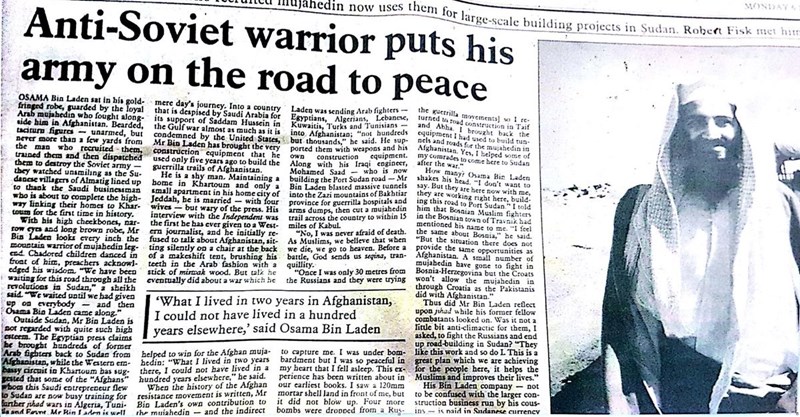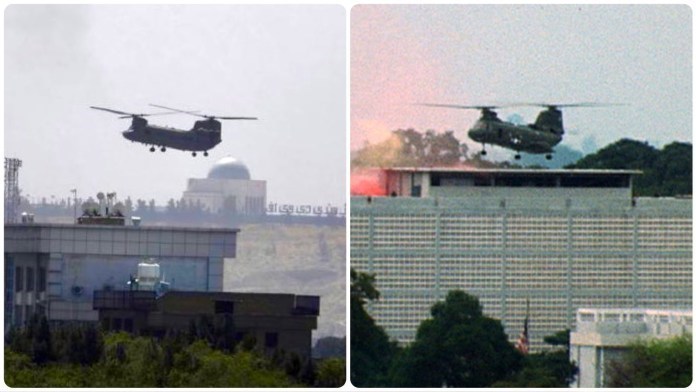August 18, 2021
By Ali Hamouch
Each time the US decides to invade a country, it starts with a poorly thought-out mass mobilization and ends up dealing with disgraceful consequences.

A new dawn is embracing Kabul today – a dawn that bears with it a load of uncertainty, bewilderment, and curiosity. What some have deemed as the fall of Kabul is seen as a rise by others, though what is certain is the massive failure of US foreign policy.
But, the real failure did not begin on the 15th of August 2021, but on the 30th of April 1975, the day the Americans lost control of Saigon, the capital of South Vietnam after 17 years of invasion, intervention, and genocides.
Despite the constant reassurance of top US officials that the Kabul retreat would not resemble that of Saigon 46 years earlier, the opposite turned out to be true.
Indeed, both scenarios bear a lot of resemblance in time and context, offering a great history lesson for those willing to learn.
The Big Bad Wolf
Vietnam
Each era leading to a US invasion was shaped or contained by an internal US policy which dictated the direction of the narrative. It stresses the view of different cultures or ideologies as an “other,” always opposed to the American Dream and its (ill-defined) values.
In the ‘50s, McCarthyism shaped the populace’s view of communism as anti-American: Named after Senator Joseph McCarthy, this strategy was the political equivalent of witch-hunting in the US. It relied on spreading terror in the hearts of those who were deemed to have communist leanings and ousting them, going as far as accusing economics professors of being communists and questioning them for the simple act of teaching Marxist economic theory.
The FBI led much of the maligned campaign, earning the title of “the single most important component of the anti-communist crusade” by historian Ellen Schrecker. The term “crusade” will be further used to justify an unjust invasion albeit half a century later.
The employment of the “Red Scare” within the US prepared the soil for any invasion as long as it pertained to “fighting communism,” which is the reason why the Vietnam War, pre-civil rights movement, was not contested much.
The Vietnam invasion occurred in 1958 at the height of the Cold War, where the US was determined to push back any attempt by the USSR to expand even on an ideological level.
This approach was backed by the Truman Doctrine, named after the 33d US President Harry Truman, which stated that “The United States would provide political, military and economic assistance to all democratic nations under threat from external or internal authoritarian forces.” In reality, this doctrine was a political frontline weapon to ensure that the US would be able to expand its military influence in any region of the world without receiving much backlash from within its apparatuses.
The war was waged against the National Liberation Front of South Vietnam, commonly known as the Viet Cong, in an attempt to control the policymaking of the country.
The war went on to become the longest in the US history at the time; it was massively contested by Americans during the civil rights era, and was even challenged by the likes of Mohammad Ali who refused to enlist for the Vietnam War, voicing his rejection by saying “No Vietnamese ever called me nigger!” Simultaneously, the human and economic cost of the war kept growing at an alarming rate.
The image of the US as a liberator came to an end during the revelation of the My Lai Massacre in 1968 in which an army unit killed large numbers of unarmed civilians after raping them.
In hindsight, the US wanted to spread “democracy” using universal values of respect and freedom as a pretext for amassing further geopolitical control of the world. All of this was planned in order to cement itself as the “Leader of the Free World.”
Afghanistan
Through what Noam Chomsky labeled as “Systematic Propaganda,” the US eventually had to change the labels of its reasons to go to war. “Anti-communism,” after the fall of the Soviet Union in 1989, became “The War on Terror.” Now, every group which espoused seemingly Islamic beliefs and did not see eye to eye with the US was deemed as “terrorist.”
But, what was peculiar about this approach and the new labeling of Taliban was the US’ support of Islamic movements from 1978 up until the end of the Soviet invasion of Afghanistan – they were seen as a powerful tool in the defeat of the USSR. Afghan Islamic fighters were a powerful ally in the US war against communism, which was eventually concluded by the collapse of the Union a few years after it retreated from Afghanistan.

So what happened to this alliance? Was the US in need of a new enemy to present itself as the gatekeeper of the new century?
The invasion of Afghanistan in 2001 took place after the occurrence of the 9/11 attacks. The shock of the Twin Towers falling signaled the end of the US’ impenetrable fort and the unipolarity of the world. In an attempt to preserve the last remnants of its power status, the US announced the “War on Terror” which would begin by invading Afghanistan and destroying the Taliban, who were accused of shielding Osama Bin Laden and other key members of Al-Qaeda.
The US decision was highly questionable, notably as most of the involved in the 9/11 attacks were Saudis and not Afghans, yet Saudi Arabia was never officially investigated or pointed at as a possible associate. The victims’ families are still demanding the release of FBI documents detailing the Saudi government’s involvement in the attacks.
Furthermore, the only nations to ever consider the Taliban as a legitimate party in power were Pakistan, the UAE, and Saudi Arabia – the latter two being close allies to the US. It now becomes clear that the invasion of Afghanistan was merely a thesis statement of sorts, a declaration of hegemonic persistence despite the severity of the attack.
However, this time, the US needed wider support to perform its next step: It forcefully enlisted the assistance of the NATO as it provided a large portion of the funding. Subsequently, the UK, Japan, and a large part of the European Union became embroiled in a war they did not comprehend.
In an infamous speech by then-President George W. Bush, he described his country’s upcoming response as a “crusade against terrorism,” voicing similar rhetoric as the one adopted during the Cold War: That of American exceptionalism and its divine right to shape the world in its image. Only this time, it did not want to shape anything, it simply wanted to preserve the shadow of its deflating empire.
The invasion of Afghanistan came just three weeks before the implementation of the Patriot Act, which legitimizes the Orwellian surveillance state. This comes in parallel with convincing a majority of Americans about the need for relinquishing their personal data to fight terrorism. Suddenly, the safety of the US became equivalent to a complete absence of privacy and personal thoughts. Through this tactic, fending off Islamic extremism just became the most radical objective of the nation, subsequently turning it into the boogeyman of the century.
Now the US was not vying to spread its value but to simply, and bluntly, preserve its interests.
A Fall from Grace
And now to the outcome of each invasion – the fall of Saigon and the fall of Kabul – not only do they bear narrative similitudes, but also picturesque ones: People being lifted from embassy rooftops, associate workers being left behind, journalists promised a safe flight back home left stranded, and a local government backed by Washington left to collapse.
But which country does the aforementioned scenery ascribe to?
Both actually, which goes to showcase how the US has learned nothing from its mistakes in Vietnam. The US should have learned its lesson by now: Guns and funds do not fundamentally alter the social structure of a country.

The Viet Cong were insurgents in the US-dominated part of Vietnam yet they persisted despite all of their enemies’ wealth and military power. The Taliban, mostly formed of Pashto groups, remained an integral part of Afghanistan’s social and political life despite attempts to uproot it and the formation of a US-backed government.
Foreign invaders will always be seen as “others” in the same way the invader describes his victims as an “other.” The dynamic is violent, with each party trying to impose its presence through all means necessary. Yet, one of them inherently adheres to the social and cultural components of the country, and the other cannot begin to comprehend it.
But, perhaps the worst outcome of these wars is that the mere talk about both countries becomes constantly entangled with the talk about the US invasion. In the collective mindset of the world, these nations are only defined through their years of war with the US troops and not through their culture, their aspirations, or heritage.
Both countries have been scarred, left to fend off for themselves; their resources depleted and their economy suffering.
On the other hand, the US’ retreat in both cases was a crystal clear humiliation, an inadvertent announcement of their foreign policy and military strategy failure. In Saigon, it erased the image of America as the defender of liberties, and in Kabul, it drew the picture of a nation in shambles that leaves its allies behind.
Regarding the US retreat from Afghanistan, Joe Biden said that they aimed “to deliver justice to Osama Bin Laden.” But, given that the US has assassinated him in 2011, what was the aim of remaining there for an additional 10 years?
Biden follows up with the following remark: “We did not go to Afghanistan to nation-build,” which showcases a clear dissociation with the “democracy spreading” discourse used decades earlier.
The head of German Chancellor Angela Merkel’s party, Armin Laschet, called the retreat “the biggest debacle the NATO has suffered since its founding.” British paper Daily Mail asked on its front page “What the hell did they all die for?”, showing a casket of a British soldier who died in Afghanistan.
So, after 20 years of endless battles in Afghanistan, what did they die for?
If the Viet Cong ruled all of Vietnam and the Taliban took Kabul in a matter of days, what was the point of wasting all of these taxpayers’ money, civilian lives, and the lives of soldiers on both sides?
A recent poll showcased that the US is mostly disapproving of Biden’s withdrawal strategy from Afghanistan….Though in reality, is there a best way to retreat from a country you have invaded after losing the longest war in your nation’s history?
Filed under: Afghanistan, American Wars, NATO, Taliban, Vietnam, War on Afghanistan | Tagged: America’s Dirty Wars, American Empire’s Decline, Bin Laden, Fall of Saigon, Viet Cong |
 RSS Feed
RSS Feed















 August 18th, 2021
August 18th, 2021  Awake Goy
Awake Goy  Posted in
Posted in  Tags:
Tags: 













